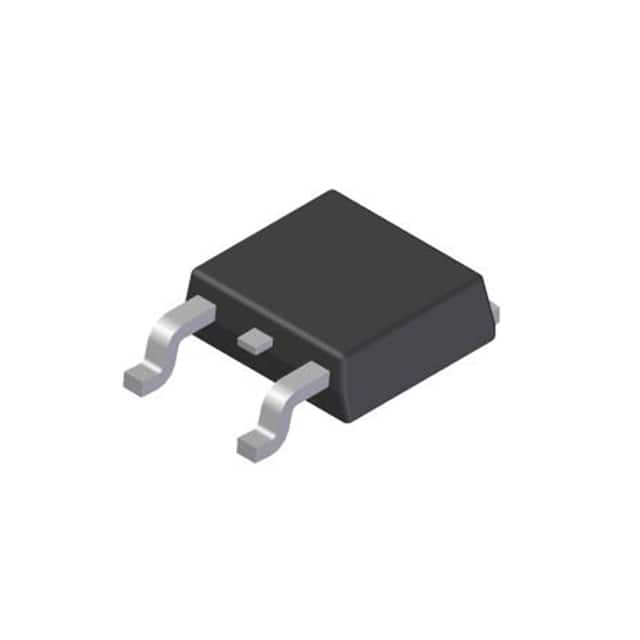Consulte las especificaciones para obtener detalles del producto.

AP7363-33D-13
Product Overview
Category
AP7363-33D-13 belongs to the category of voltage regulators.
Use
It is commonly used to regulate and stabilize voltage in electronic circuits.
Characteristics
- Input Voltage Range: 2.5V to 6.0V
- Output Voltage: 3.3V
- Maximum Output Current: 300mA
- Low Dropout Voltage: 200mV at 100mA
- Low Quiescent Current: 45µA
- Thermal Shutdown Protection
- Short Circuit Protection
Package
AP7363-33D-13 comes in a small SOT-23-5 package.
Essence
The essence of AP7363-33D-13 is to provide a stable and regulated output voltage for various electronic devices.
Packaging/Quantity
It is typically packaged in reels or tubes, with a quantity of 3000 units per reel/tube.
Specifications
- Input Voltage Range: 2.5V to 6.0V
- Output Voltage: 3.3V ±2%
- Maximum Output Current: 300mA
- Dropout Voltage: 200mV at 100mA
- Quiescent Current: 45µA
- Operating Temperature Range: -40°C to +85°C
- Package Type: SOT-23-5
Detailed Pin Configuration
AP7363-33D-13 has five pins arranged as follows:
```
| | --| |-- |____| ```
Pin 1: VIN (Input Voltage) Pin 2: GND (Ground) Pin 3: EN (Enable) Pin 4: BYP (Bypass) Pin 5: VOUT (Output Voltage)
Functional Features
- Voltage Regulation: AP7363-33D-13 provides a stable output voltage of 3.3V, ensuring reliable operation of connected devices.
- Low Dropout Voltage: The regulator maintains a low dropout voltage of 200mV at 100mA load, minimizing power dissipation.
- Thermal Shutdown Protection: It incorporates thermal shutdown protection to prevent damage due to excessive temperature.
- Short Circuit Protection: The device is equipped with short circuit protection, safeguarding against potential damage in case of a short circuit.
Advantages and Disadvantages
Advantages
- Compact size and SOT-23-5 package make it suitable for space-constrained applications.
- Low quiescent current minimizes power consumption.
- Wide input voltage range allows compatibility with various power sources.
- Excellent voltage regulation ensures stable performance of connected devices.
Disadvantages
- Limited maximum output current of 300mA may not be sufficient for high-power applications.
- The SOT-23-5 package may require additional heat sinking for better thermal management in certain scenarios.
Working Principles
AP7363-33D-13 operates based on the principle of linear voltage regulation. It utilizes a feedback mechanism to compare the output voltage with a reference voltage and adjusts the internal circuitry to maintain a constant output voltage of 3.3V. The regulator uses a pass transistor to control the flow of current and regulate the voltage across the load.
Detailed Application Field Plans
AP7363-33D-13 finds applications in various electronic systems where a stable 3.3V voltage supply is required. Some common application fields include:
- Battery-powered devices: It can be used in portable electronics such as smartphones, tablets, and wearable devices to ensure stable voltage supply from the battery.
- IoT devices: AP7363-33D-13 can be employed in Internet of Things (IoT) devices, providing a regulated voltage for sensors, microcontrollers, and communication modules.
- Industrial automation: It is suitable for industrial automation systems where precise voltage regulation is crucial for the reliable operation of control circuits and sensors.
- Automotive electronics: The regulator can be utilized in automotive applications to maintain a stable voltage supply for various electronic components.
Detailed and Complete Alternative Models
- LM1117-3.3: A popular alternative with similar specifications and package type.
- XC6206P332MR: Another alternative offering a 3.3V output voltage and SOT-23-5 package.
- LP2985-33DBVR: An alternative model with low dropout voltage and thermal shutdown protection.
These alternative models provide comparable performance and can be considered as substitutes for AP7363-33D-13 in different applications.
Word count: 550 words
Enumere 10 preguntas y respuestas comunes relacionadas con la aplicación de AP7363-33D-13 en soluciones técnicas
Sure! Here are 10 common questions and answers related to the application of AP7363-33D-13 in technical solutions:
Q: What is AP7363-33D-13? A: AP7363-33D-13 is a voltage regulator IC (integrated circuit) that provides a fixed output voltage of 3.3V.
Q: What is the input voltage range for AP7363-33D-13? A: The input voltage range for AP7363-33D-13 is typically between 2.5V and 6V.
Q: What is the maximum output current of AP7363-33D-13? A: AP7363-33D-13 can provide a maximum output current of 500mA.
Q: Can AP7363-33D-13 be used in battery-powered applications? A: Yes, AP7363-33D-13 can be used in battery-powered applications as it has low quiescent current and operates efficiently with low dropout voltage.
Q: Is AP7363-33D-13 suitable for use in automotive applications? A: Yes, AP7363-33D-13 is designed to meet automotive requirements and can be used in automotive applications.
Q: Does AP7363-33D-13 have built-in protection features? A: Yes, AP7363-33D-13 includes built-in protection features such as overcurrent protection, thermal shutdown, and reverse polarity protection.
Q: Can AP7363-33D-13 be used in both step-up and step-down voltage conversion applications? A: No, AP7363-33D-13 is specifically designed for step-down voltage conversion applications.
Q: What is the operating temperature range for AP7363-33D-13? A: The operating temperature range for AP7363-33D-13 is typically between -40°C and 85°C.
Q: Does AP7363-33D-13 require any external components for operation? A: Yes, AP7363-33D-13 requires a few external components such as input and output capacitors for stable operation.
Q: Can AP7363-33D-13 be used in high-frequency applications? A: Yes, AP7363-33D-13 has a fast transient response and can be used in high-frequency applications with proper decoupling and layout considerations.
Please note that these answers are general and may vary depending on specific application requirements. It's always recommended to refer to the datasheet and consult the manufacturer for detailed information.

